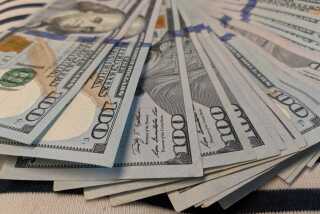Some Signs of an Upturn For a Well-Battered Dollar
- Share via
At the beginning of 1986, the U.S. dollar exchanged for 200 Japanese yen. Currently, the dollar’s exchange rate is about 140 yen.
In the next 6 to 12 months, the dollar’s value relative to the yen is, I believe, likely to rise appreciably--a forecast that runs against much of the current conventional wisdom.
To place this forecast in perspective, it’s worth noting that the U.S. global trade deficit (goods and services) in 1986 was $135 billion, and the bilateral deficit with Japan was about half this total. In 1987, the global deficit will probably be in the neighborhood of $150 billion, of which about $80 billion will consist of the bilateral deficit with Japan.
What lies behind this forecast of a climb in the dollar’s value are several factors which will, respectively, increase international demand for dollars by holders of yen, and reduce the supply of dollars for making international payments in yen. When the demand for something rises and its supply declines, the result is an increase in its price--in this case, the price or exchange value of the dollar.
The demand for dollars by holders of yen will tend to rise for several reasons: The price/earnings ratios prevailing in Japanese stock markets are three or four times higher than those prevailing in U.S. markets. (Even allowing for foreign exchange risks, this relative inflation of Japanese price/earnings ratios will make U.S. equities look especially attractive to holders of yen assets).
Also, real property values in Tokyo and other major Japanese cities are similarly inflated relative to land prices in U.S. urban areas (land prices in Tokyo have risen by 200% over the past two years), thereby making acquisition of real property increasingly attractive to Japanese real estate investors and developers.
The prospective reduction in the supply of dollars for making international payments to Japan is likely to come about primarily through domestic U.S. production substituting for some imports, and secondarily from increased U.S. exports. Both of these developments are likely to result, if somewhat belatedly, from the depreciation of the dollar relative to the yen which has already occurred, together with the rise in Japan’s real labor costs relative to those in the United States. These two effects will make U.S. products more competitive with those from Japan, especially in the U.S. market and, perhaps with some delay, in the Japanese market, as well.
Finally, one additional factor will contribute to a further strengthening of the dollar. The Federal Reserve Board’s chairman, Alan S. Greenspan, shows that he plans to maintain at least as tight a monetary policy as former chairman Paul A. Volcker. Greenspan wants to demonstrate that his anti-inflationary commitment is not less than Volcker’s. Somewhat higher real interest rates in the United States will make U.S. debt instruments more attactive to foreign asset holders.
Of course, all of this still falls short of an unqualified, ironclad prediction. Counter-arguments and influences can be cited that may offset some of these tendencies: for example, government spending may be boosted in an election year, resulting in reversing the downward trend in the federal budget deficit; or private savings in the United States might decline futher and consumer spending might reignite, thereby generating increased demand for Japanese, as well as other, imports.
However, the tendencies mentioned earlier add up to a much stronger case for anticipating an appreciation, rather than a depreciation, of the dollar in the forthcoming months.
Macroeconomics is not so much a “dismal science,” as it is simply a profoundly uncertain one. As someone once said, “Half of what we know about macroeconomics is wrong; the trouble is we’re not quite sure which half.”
More to Read
Inside the business of entertainment
The Wide Shot brings you news, analysis and insights on everything from streaming wars to production — and what it all means for the future.
You may occasionally receive promotional content from the Los Angeles Times.









